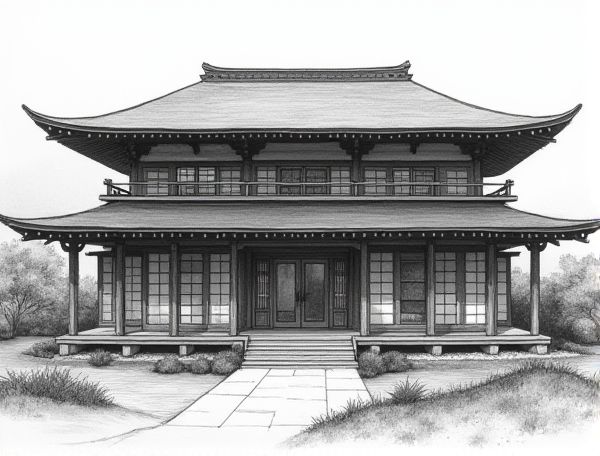
Photo illustration: Japandi home design with charred shou sugi ban wood
Japandi home design masterfully blends Japanese minimalism with Scandinavian warmth, and incorporating charred Shou Sugi Ban wood enhances this aesthetic by adding a striking, durable, and naturally weather-resistant element. Explore the article to discover how this unique wood treatment can elevate your living space with timeless elegance and functional beauty.
Introduction to Japandi Home Design
Japandi home design combines the simplicity of Japanese minimalism with the warmth of Scandinavian functionality, creating a serene and stylish living space. Your interior will emphasize natural materials, clean lines, and neutral tones, promoting both tranquility and comfort. This blend prioritizes functionality and aesthetic balance, making your home a peaceful retreat.
The Origins of Shou Sugi Ban Wood
Shou Sugi Ban wood originates from Japan, where it has been used for centuries as a traditional method of wood preservation by charring the surface with fire. This technique enhances the wood's durability, making it resistant to insects, rot, and weather damage while imparting a distinct dark, textured appearance. The process typically involves burning, cooling, cleaning, and finishing, often applied to cedar or cypress, which are commonly used for home siding and interior design.
Harmonizing Japandi Aesthetics with Charred Wood
Integrating charred wood, or shou sugi ban, enhances Japandi design by emphasizing natural textures and deep, rich tones that contrast with minimalist, light-toned interiors. This technique adds durability and a rustic elegance to the space, creating a balanced blend of Scandinavian simplicity and Japanese wabi-sabi imperfection.
Benefits of Using Shou Sugi Ban in Interior Spaces
Shou Sugi Ban enhances interior spaces by providing a unique, charred wood finish that offers exceptional durability and resistance to moisture, insects, and fire. Your home benefits from its eco-friendly, low-maintenance qualities, combined with a striking, textured aesthetic that adds warmth and character to any room.
Color Palettes and Material Pairings
Choosing the right color palettes and material pairings transforms your home design into a cohesive and inviting space. Neutral tones combined with natural materials like wood and stone create a timeless aesthetic, while bold hues paired with metallic accents offer a modern, dynamic feel. Your carefully selected color schemes and textures enhance visual interest and reflect your personal style seamlessly.
Japandi Furniture Accents with Charred Wood Finishes
Japandi furniture accents with charred wood finishes create a perfect blend of Japanese minimalism and Scandinavian warmth, enhancing your home with natural textures and sleek, functional designs. These pieces emphasize simplicity and durability, offering a calming atmosphere while showcasing unique, handcrafted aesthetics that complement modern interiors.
Creating Minimalist Warmth: Lighting and Texture
In minimalist home design, combining warm lighting with textured materials enhances coziness without clutter. Soft, adjustable LED lighting paired with natural fabrics like wool and linen creates an inviting atmosphere. Incorporating tactile elements such as wooden surfaces and woven textiles adds depth and warmth while maintaining sleek simplicity.
Eco-Friendly Aspects of Shou Sugi Ban
Shou Sugi Ban, a traditional Japanese wood preservation technique, enhances eco-friendly home design by using charred cedar wood that is naturally resistant to rot, insects, and fire, eliminating the need for harmful chemical treatments. This sustainable method extends the lifespan of exterior cladding while reducing environmental impact through the use of renewable materials and minimal maintenance requirements.
Maintenance Tips for Charred Wood Surfaces
Charred wood surfaces require regular inspection to prevent moisture buildup and mold growth, especially in humid environments. Applying a high-quality sealant every 1-2 years helps maintain the wood's durability and enhances its resistance to weathering. Cleaning with a soft brush and mild detergent preserves the texture and prevents damage to the charred layer.
Inspiring Japandi Homes with Shou Sugi Ban Features
Inspiring Japandi homes seamlessly blend minimalist Japanese aesthetics with Scandinavian functionality, enhanced by the unique Shou Sugi Ban technique that preserves wood through charring, adding durability and striking texture to exterior and interior walls. Your space can achieve a timeless, eco-friendly appeal with the natural, weather-resistant qualities and rich, dark hues of Shou Sugi Ban, creating a harmonious balance of warmth and modern simplicity.
 homedesy.com
homedesy.com